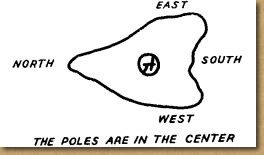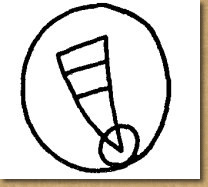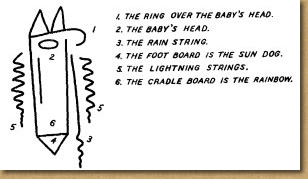
Go to: Age of Gods - Navaho Index
In the Age of Gods: All during this time First Man and First Woman lived on the top of Dzil na'odili, also called Chol'i'i. This is the sacred mountain near Farmington, N. Alex. The circle on top of this mountain is a cloud Chol'i'i was completely hidden at first, then the bands or clouds rose and the mountain was seen. This is the sacred story which the old medicine men keep to themselves.

The sacred mountain Dzil na'odili, also called Chol'i'i.
The cradle and how the baby lay in it.
 The cradleboard is the rainbow.
The cradleboard is the rainbow.

The cloud circle on top of the mountain.

The cradle of the White Bead Baby.
note: The two sisters were the mothers of the "Twins"; one, Estsanatlchi, was the Woman-Who-Changes (the turquoise image), and that Yol'kai estan is the White Bead Woman. The Sun and the Water Fall were the fathers of the boys. Lummis, in Pueblo Indian Folk Stories, associates the mother of the Twins with the moon.
note: The mountain on which the White Bead Baby was found is sometimes designated as Chol'i', and sometimes as the Mountain of the Fast, Sis'na'jin.
 The baby was the White Bead Baby, the female baby, and her cradle is called natsi'lid eta cote, the rainbow cut short. The baby was wrapped in four clouds, black, blue, yellow, and white, and the four vapors, and all the flowers with all their pollens. The baby's head was to the west and her feet were to the east.
The baby was the White Bead Baby, the female baby, and her cradle is called natsi'lid eta cote, the rainbow cut short. The baby was wrapped in four clouds, black, blue, yellow, and white, and the four vapors, and all the flowers with all their pollens. The baby's head was to the west and her feet were to the east.
First comes the story of the White Bead Baby and of her growth. One day the mountain Chol'i'i was hidden by clouds and First Man said to his wife: "Now for the whole day we have seen clouds over the mountain. There must be some reason for this." That night when he saw a fire on the top of the mountain First Man said: "All day the clouds have covered the mountain and now there is a fire there. There must be someone there. I will go and find him." His wife said: "No, stay at home. There are many monsters on the earth who eat people. It is not safe for you to go." But First Man said: "I will go. It must be the will of the Most High Power." The next day he started out, chanting as he walked. He called himself the Dawn Boy in the chant. He climbed the mountain, but he found nothing, neither fire nor hogan. All that second day the clouds hung over the mountain, and when First Man returned home that night both be and his wife saw the fire burning on top of Chol'i'. The next day First Man went again to the mountain but he found no fire or home or sign, so he returned to his home. That night when he saw the fire burning brightly he planted two forked sticks and sighted the fire, so that on the following day he could look and see at what point the fire had burned. In the morning, when he looked through the forked sticks, he knew just where to go. He started out as before and be chanted as he walked, naming the mountain toward which he was going, until he reached the top. On the top of the mountain there was a heavy mist. In the center of it he heard a baby crying. Lightning flashed from the baby and First Man saw her on her cradleboard.
First Man picked the baby up and carried her home to his wife. But the baby was tied firmly on the cradleboard and First Woman did not know how to untie the strings. Just at this time they heard a noise: "ho'ho'ho'hooo." Then another noise: "A'ow, a'ow, ho'ho'ho'hooo." And two men entered the home. One said that his name was Ni'hada ho'nigi (he was Hasjelti), the other said he was Ni'ha ha nigi (Hasjohon). They were the two Yei. They told First Man and his wife that the baby had been their plan, and they showed them how to untie the cradle strings and told them what each string meant. Next they told First Man to go out and cut two slabs of wood from a tree, and to mark the tree, and to make from oak the bow for over the baby's head. They told him that he must make a cradle like this first
one. He must gather the soft bark from awae'ts al, the baby bush or cliff rose, and place that on the board before putting the baby on it. So First Man went out and made the cradle as the Yei had directed, for they took away the cradle on which the baby had been found. But before the two Yei left First Man said: "Now she will be my daughter." His wife took the baby and breathed on her four times. "Now", she said, "she will he my daughter." And so the Yei left First Man and his wife.
First Woman washed the baby in a white bead basket, then in a turquoise basket, and in a white shell basket, and in a black jet basket. At the end of the second day the baby laughed for the first time and there came a man, Atse'hashke, the First Coyote, who said: "I was told that my grandchild laughed for the first time." A woman came saying: "I was told that my grandchild laughed for the first time." She was the Salt Woman. First Woman took charcoal and gave it to the Coyote saying: "This is the only thing that lasts." So he painted his nose with it and said: "I shall know all things. I shall live long by it." And First Woman also gave the Coyote salt. He swallowed it and said: "This shall be my meat. It will make my meat taste good.," And satisfied with his gifts he departed. It was the Salt Woman who first gave the gift of salt to First Woman. Then the two Yei returned for their gifts. One was given white bead moccasins, and the other decorated leggings. They took them and went away satisfied.
Now that is why all persons present receive a little gift when a baby laughs for the first time. And later, when the White Bead Woman went West to her home she gave the gifts of beautiful flowers, the rain, and the plants bearing fruits and seeds for food.
The third day the baby sat up, the fourth day she walked. When the baby stood First Man put her on his knee and sang:
The old woman standing,
The old woman standing,
The old woman standing.
The White Bead Girl is standing.
The chant continues. It tells what developed on each day and how the White Bead Girl grew until the thirteenth day when she had her monthly period. (The same things happen to girls now, but the days of the White Bead Girl became our years.) On the thirteenth day she went to her foster-mother and said: "Something unusual has passed through me." First Woman spoke: "That is your 'first race.'"
note: The soft shredded bark of the cliff rose is used to line the baby basket.
note: The origins of the First Laugh Ceremony.
First Woman told her husband that their foster daughter had kin nas ta, her first race (first menstruation), also called her first cake.
They laid different kinds of blankets inside the home. Under them were the white flowers, coyote robes, and such things. The girl lay stretched on these, face down. First Man shaped her all over. He pulled her hair down and she had a quantity of hair. He shaped her face and it was beautiful, and he dressed her in all the beautiful goods, beads, bracelets, and earrings. They let her hair hang down and they tied it at the neck with the rain string which hung down with her hair.
Then First Man and First Woman stepped outside the hogan and told her to run her first race, to go around a cedar tree yonder, as the sun travels, and return home. When she came back she looked from the doorway into the home and said: "You hid the ground with the beautiful goods, you hid the ground with the mixed chips of stones." Now this is what First Man and First Woman had said.
First man commenced planning where they should have the first chant over her. It was decided that it would be in the home on the top of the eight rings of the mountain called Dzil na'odili, at the home which is called hoghan ho'tez sos, Changeable House. The Home that Stretches Out, hogan na' hat tson'e is its second name.
A great crowd gathered the evening of the fourth day. All the different people filled the home and there were 11 rings, or 11 circles, of people around it. As the chant was about to begin some people put their heads inside the home and said: "Why were we not invited?" And everyone said: "Come in. There is room in front for you." These newcomers were the Beautiful Goods People, a whole group of them. They sat in front of the others.
Two hogan chants were sung by the people who, planned how the White Bead Baby should be found. Then the White Bead Girl stood up and said that there was something missing. "You have not called upon Tse an no'hoi begay hojone, the Most High Power Whose Ways Are Beautiful," she said. "He should be put into your songs. No one knows his real name, but you must use the one I give you." So all the people sang their chants using the names of the Most High Power and that of the White Bead Girl.
About dawn two men came in and asked why they had not been invited. Their moccasins and leggings were white; they were beautifully dressed, each having 21 tail feathers for the headdress, and on the top of each feather there perched a beautiful singing bird. They were the two Yei, Hasjelti, the Dawn, and Hasjohon, the Twilight. They received gifts and they came in and sang their chant, and the dawn broke and it was day.
note: The white flowers are the mariposa lily.
note: Chants are sung here. They tell how the baby was found, about her growth, her first "race" or "cake," and when she went to the West and returned. No one man knows all the chants, only one group of them.
So now each girl at the time of her first and second "race" has this chant held over her. Her cake is made of the different colored corn flavored with a kind of yeast. This latter is made by soaking wheat in water and when it ferments it is dried and ground into powder. It makes the corn cake very sweet.
In the morning the men receive some of the maiden's cake as their gift for their chants. Today the young girl sits in the back of the hogan and the goods or gifts are piled in front of her, symbolic of the Beautiful Goods People who filled the front circle in the "hogan" when the White Bead Girl had her first chant. The young girl, today, has her hair tied with a strip of buckskin from a deer not killed by a weapon.
Now after the ceremony or Night Chant over the White Bead Girl the people went their ways and left First Man and First Woman and their foster daughter to live by themselves. It happened soon after this that this holy girl wished for a mate. Every morning when the sun rose she lay on her back until noon, her head to the west and her feet to the east. From noon on she went to the spring. She lay under the ledge and let spring water drip over her body. This took place each day for 4 days.
Go to: Age of Gods - Navaho Index